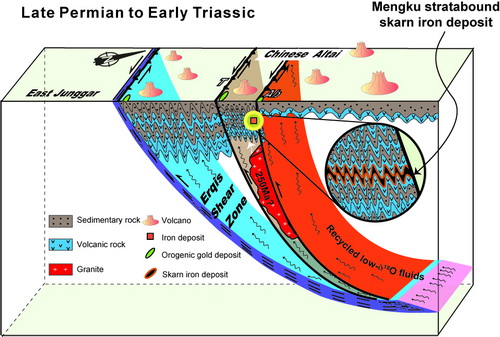Iron mineralization associated with a major strike-slip shear zone: Radiometric and oxygen isotope evidence from the Mengku deposit, NW ChinaUpdate time:06 08, 2012
Vice Professor WAN Bo and his team conduct a systematic study of the Mengku iron deposit in the Chinese Altai, Northwest China. They build a spatial and temporal relationship between iron mineralization and a major shear-zone, based on field observations, isotope dating and source tracing. It proposes a new model for the genesis of the Mengku iron deposit. They suggest that the Mengku is not a volcanogenic massive sulfide deposit, but is related to the Erqis strike–slip shear zone and Abagong Fault, which acted as fluid conduits. The upwelling of hot mantle in the Permian to Triassic supplied the heat, and thereby caused material to dehydrate and mixed with meteoric water that give rise to low-oxygen isotope fluids similar to the common genetic model for orogenic lode gold deposits.
Fig. 1. Model of ore genesis of the Mengku deposit. (Image by WAN) Wan et al. Iron mineralization associated with a major strike-slip shear zone: Radiometric and oxygen isotope evidence from the Mengku deposit, NW China. Ore Geology Reviews. 2012, 44:136-147(Download Here)
|
Contact
Related Articles
Reference
|
-
SIMSSecondary Ion Mass Spectrometer Laboratory
-
MC-ICPMSMultiple-collector ICPMS Laboratory
-
EM & TEMElectron Microprobe and Transmission Electron Microscope Laboratory
-
SISolid Isotope Laboratory
-
StIStable Isotope Laboratory
-
RMPARock-Mineral Preparation and Analysis
-
AAH40Ar/39Ar & (U-Th)/He Laboratory
-
EMLElectron Microscopy Laboratory
-
USCLUranium Series Chronology Laboratory
-
SASeismic Array Laboratory
-
SEELaboratory of Space Environment Exploration Laboratory
-
PGPaleomagnetism and Geochronology Laboratory
-
BioMNSFrance-China Bio-mineralization and Nano-structure Laboratory

 Print
Print Close
Close
